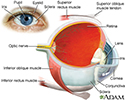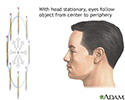Extraocular muscle function testing
EOM; Extraocular movement; Ocular motility examination
Extraocular muscle function testing examines the function of the eye muscles. A health care provider observes the movement of the eyes in eight specific directions.
How the Test is Performed
You are asked to sit or stand with your head up and looking straight ahead. Your provider will hold a pen or other object about 16 inches or 40 centimeters (cm) in front of your face. The provider will then move the object in several directions and ask you to follow it with your eyes, without moving your head.
A test called a cover/uncover test may also be done. You will look at a distant object and the person doing the test will cover one eye, then after a few seconds, uncover it. You will be asked to keep looking at the distant object. How the eye moves after it is uncovered may show problems. Then the test is performed with the other eye.
A similar test called an alternate cover test may also be done. You will look at the same distant object and the person doing the test will cover one eye, and after a couple of seconds, shift the cover to the other eye. Then after a couple more seconds, shift it back to the first eye, and so on for 3 to 4 cycles. You will keep looking at the same object no matter which eye is covered.
How to Prepare for the Test
No special preparation is necessary for this test.
How the Test will Feel
The test involves only normal movement of the eyes.
Why the Test is Performed
This test is performed to evaluate weakness or other problems in the extraocular muscles. These problems may result in double vision or rapid, uncontrolled eye movements.
Normal Results
Normal movement of the eyes in all directions.
What Abnormal Results Mean
Eye movement disorders may be due to abnormalities of the muscles themselves. They may also be due to problems with the nerves that connect to these muscles or in the sections of the brain that control these muscles. Your provider will talk to you about any abnormalities that may be found.
Risks
There are no risks associated with this test.
Considerations
You may have a small amount of uncontrolled eye movement (nystagmus) when looking to an extreme left or right position. This is normal.
References
Cioffi GA, LIebmann JM. Diseases of the visual system. In: Goldman L, Schafer AI, eds. Goldman-Cecil Medicine. 26th ed. Philadelphia, PA: Elsevier; 2020:chap 395.
Demer JL. Anatomy and physiology of the extraocular muscles and surrounding tissues. In: Yanoff M, Duker JS, eds. Ophthalmology. 5th ed. Philadelphia, PA: Elsevier; 2019:chap 11.1.
Forrester JV, Dick AD, McMenamin PG, Roberts F, Pearlman E, Physiology of vision and the visual system. In: Forrester JV, Dick AD, McMenamin PG, Roberts F, Pearlman E, eds. The Eye. 5th ed. Philadelphia, PA: Elsevier; 2021:chap 5.
Shuey NH. Ocular myasthenia gravis: a review and practical guide for clinicians. Clin Exp Optom. 2022;105(2):205-213. PMID: 35157811 pubmed.ncbi.nlm.nih.gov/35157811/.
Wallace DK, Morse CL, Melia M, et al. Pediatric eye evaluations preferred practice pattern: I. vision screening in the primary care and community setting; II. Comprehensive ophthalmic examination. Ophthalmology. 2018;125(1):P184-P227. PMID: 29108745 pubmed.ncbi.nlm.nih.gov/29108745/.
Review Date: 2/12/2023
Reviewed By: Franklin W. Lusby, MD, Ophthalmologist, Lusby Vision Institute, La Jolla, CA. Also reviewed by David C. Dugdale, MD, Medical Director, Brenda Conaway, Editorial Director, and the A.D.A.M. Editorial team.




